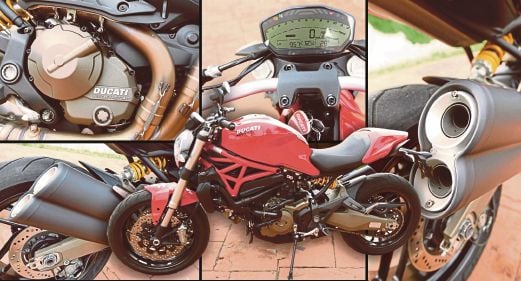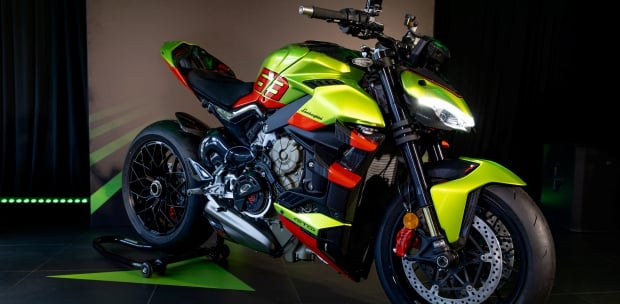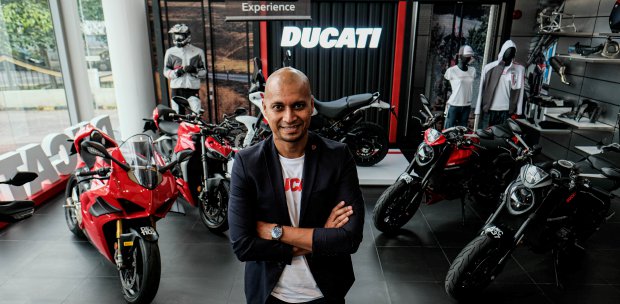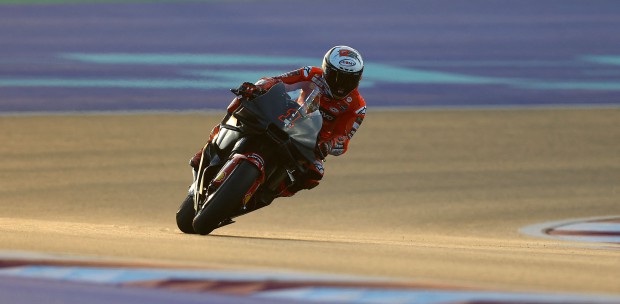DUCATI’S Monster has always been a firm favourite of Ducatisti.
The model that reversed Ducati’s fortunes in the mid-90s will never be forsaken by its creators and this is borne out by the numerous updates the Monster range has been subjected to. Alas, the original blueprint for a simple, great-handling, not-particularly-powerful naked bike has been lost. Or has it?
The original 1993 Monster 900 used the trellis frame of the 888 Superbike racer mated to the running gear of the SuperSport 750 and powered by the ubiquitious engine of the SuperSport 900. A bitsa it may have been, but it was cheap to produce and the gorgeous styling made it Ducati’s biggest seller. Its virtues of lightweight simplicity with style guaranteed it global success.
But in a quest for parity with the Monster’s by now numerous competitors, in 2001 the Monster range saw liquid-cooling and 4 valve heads in the form of the S4, derived from Ducati’s Superbike of the day. Simplicity was sacrificed. Times were a-changing. The biggest change came in 2007, with the advent of the 696 and 1100, then the 795/796 Monsters. The styling had been changed to a more up-to-date Transformer/Terminator look. The year 2014 saw the Monster range get more radical styling tweaks. All ties to the old M900 were untethered entirely. And thus, we come to the 821.
The shock of seeing the 696 Monster in 2007 sporting its new clothes have worn off altogether. The 821 looks familiar, even benign. In many ways, the 821 has watered down the radical 696’s looks somewhat and perhaps it nods a bit more to the old M900. Be that as it may, the 821 still looks as if it may pounce and bite your head off if you stare at it a bit too long. Like it? We love it.
The 821 was released in 2015 and no changes were made for 2016. It is assembled in Thailand and none the worse for it. The fit and finish is as if it comes from Italy. No corners cut here. One notable difference though: it would cost more if it was imported from Italy. Raise a glass to the Thais.
The Monster 821 is dominated by its powerplant, the same second generation 821cc 11-degree Testastretta as in the Hypermotard. It produces 112hp and 94Nm of torque. More than adequate with a dry weight of 179.5kg (wet weight 205.5kg). The power runs through a six speed gearbox transmitted through a wet slipper clutch. The fly-by-wire throttle is connected to twin 53mm throttle bodies and expels spent gases through a stainless steel twin-exit muffler. It makes great burbling noises and backfires on the overrun, like a proper Ducati should. How they get it through the noise regulators in Europe still baffles (get it?) the Japanese manufacturers.
Standard features are ABS and TCS, packed as DSP, or the Ducati Safety Pack. It has 3 levels of ABS and 8 levels of TCS intervention. Three riding modes are available; Sport, Touring and Urban, each with levels of ABS and TCS. Sport offers quick throttle response, while Touring mutes it down in the lower RPMs. Both allow the full power to be available. Urban mode limits power to 75 hp and mutes throttle response further, making it almost a Rain mode. Helpfully, these modes are available easily via the left switchgear, although changing modes on the fly require the throttle to be fully shut. The clear LCD gauge is comprehensive and even has a clock. But the 821 does not come with a fuel gauge, only a reserve warning indicator. Reserve fuel is good for at least 60km.
Chassis-wise, the Monster 821 is equipped with basic suspension, a non-adjustable Kayaba upside-down fork at the front and a preload and damping adjustable Sachs monoshock at the rear end. The suspension may be basic, but the action is neither crude nor wallowy. The Monster is set up plush with firm damping making it very comfortable around town while allowing it to hustle quickly in the twisty bits. Quite a juggling act for basic suspension to pull off, but it does it with aplomb. The brakes are excellent 320mm twin discs with radially mounted Brembo M4-32s and a radial master cylinder. The rear is standard Brembo fare, a two-piston affair clamping a 245mm disc.
First impressions on the 821 are very favourable. Ducati has moved the handlebars back 40mm and tweaked the geometry of the bike. Your weight is less centred on the handlebars and the effect is quite apparent if you have sampled previous Monsters. Tight manoeuvres are now easy and the bike feels more balanced and secure. Second impression is that the 821’s horsepower is easily accessible, a rash throttle hand will see off the rear tyre at the rate of knots. This bike likes being taken by the scruff of the neck and shaken hard. Glad to see that the Monster has not lost sight of its roots. Gear selection is paramount, as usual for a Ducati, as is clutch control for smooth transitions through the usual KL snarl-ups. Get it right and the 821 is a willing partner.
In the twisties, it is no longer necessary to handle the Monster like an overgrown MX bike. Point your inside shoulder and the 821 obliges. Easy handling and supple suspension? Could this really be a Monster? But it appears that Ducati has lengthened the wheelbase by 30mm and increased the trail figures to 93.2mm (the chassis tweaks mentioned earlier). The softer suspension also helps the cause for better handling.
The Monster 821 is a completely reformed Monster. It asks little of the rider and offers a lot in return. This is not just an update in the Monster line-up, it starts a new thread of its own. The 821 is most definitely and unarguably the best balanced Monster ever. I could tell you the price but apparently there are deals to be had at all Ducati dealers soon. Make sure you try out the demo bike at Nextbike Ducati in Jalan 222, Petaling Jaya, Selangor. Get your own ruffian in a three-piece suit: this one’s mine.






